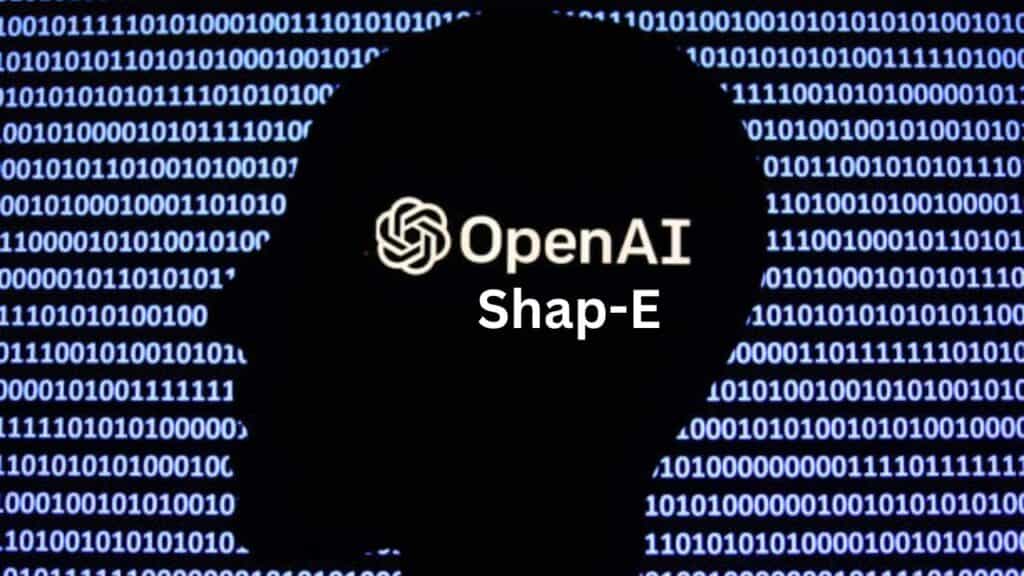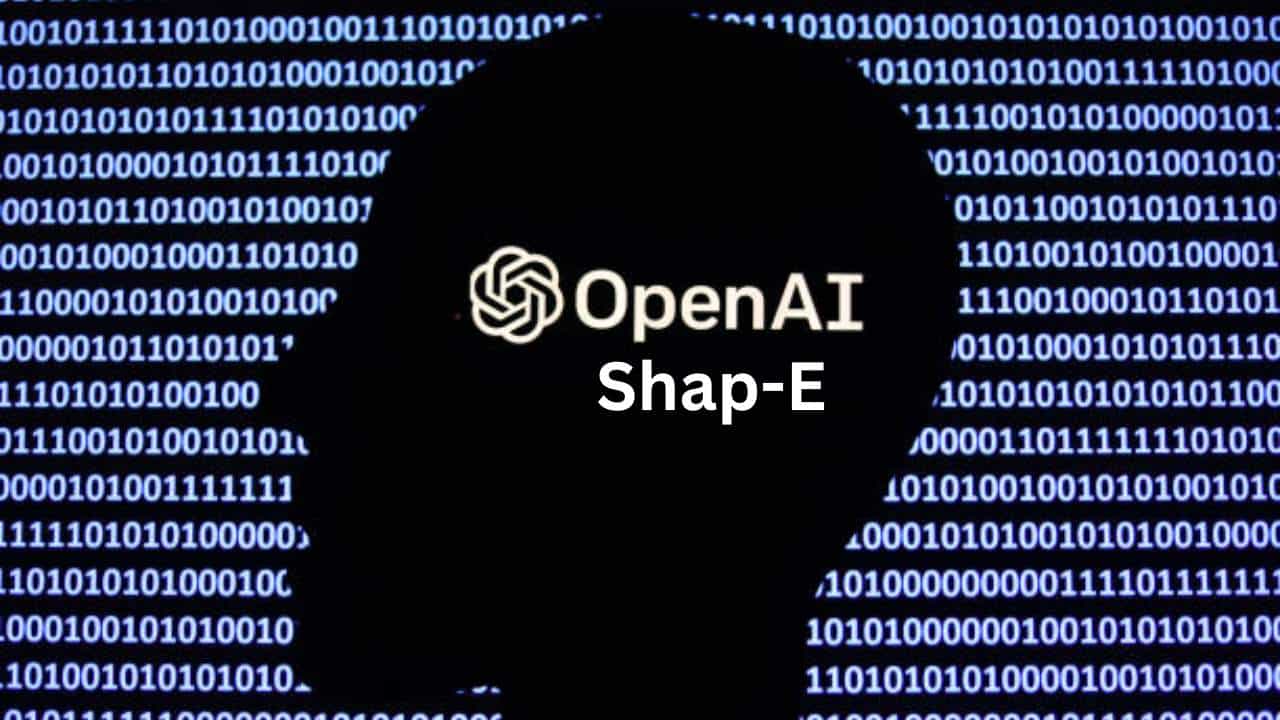OpenAI consistently introduces advancements that bring immense benefits to humanity. Alongside widely acclaimed tools such as ChatGPT, DALL-E, and Point-E, OpenAI has recently unveiled an innovative addition called Shap-E.
So, what exactly is Shap-E from OpenAI, and how can it enhance your experience? Let’s find out!

What Is OpenAI’s Shap-E?
Shap-E is an innovative tool developed by OpenAI that utilizes conditional generative models for generating 3D assets. It is trained on a large dataset of paired 3D images and text, allowing it to generate realistic and diverse 3D models from text or image inputs.
Shap-E employs a transformer-based encoder-decoder architecture and a neural network to learn a latent representation of 3D shapes. By combining these components, it can produce novel views of shapes and associate text or images with corresponding 3D models.
The generated 3D outputs from Shap-E come in two forms: textured meshes and neural radiance fields (NeRFs). Textured meshes are polygonal models with surface colors and are suitable for low-resolution shapes with simple geometry and texture. On the other hand, NeRFs are continuous functions that map 3D coordinates to colors and densities, capturing high-resolution shapes with complex geometry and appearance. Text prompts or images can be used as inputs to Shap-E to generate these 3D outputs.
Shap-E extends the capabilities of its predecessor, DALL-E, which focuses on generating 2D images from text prompts. It leverages the concept of implicit functions, which define shapes mathematically, to generate 3D assets. This approach allows Shap-E to generate diverse 3D shapes based on a given input, such as text descriptions or images.
How You Can Use OpenAI’s Shap-E?
Unlike other OpenAI tools, Shap-E has not been released to the public, but you can access its model weight, inference code, and samples by downloading them from the Shap-E GitHub page. To use Shap-E, you can proceed with the following guidelines:
- Download and Install: Once you have downloaded the Shap-E code and model weights from the Shap-E GitHub page, install the necessary dependencies using Python’s pip command. It’s important to note that Shap-E is resource-intensive and requires an NVIDIA GPU and a high-performance CPU for optimal performance.
- Local Execution: Unlike other OpenAI tools, Shap-E runs locally on your PC, eliminating the need for an OpenAI API key or an internet connection. This allows you to have full control over the tool’s functionality.
- Jupyter Notebooks: OpenAI provides several sample Jupyter notebooks that demonstrate different use cases of Shap-E.
- Text-to-3D: Using the “sample_text_to_3d.ipynb” notebook, you can generate a 3D model based on a text prompt. Enter the desired text, and Shap-E will produce an animated GIF showcasing the model from various angles. Additionally, a PLY file is generated, which can be opened in programs like Paint 3D or Blender.
- Image-to-3D: The “sample_image_to_3d.ipynb” notebook allows you to generate a 3D model conditioned on an image. Upload an image of your choice, and Shap-E will generate a similar output as the text-to-3D notebook, providing an animated GIF and a PLY file representing the generated 3D model.
- Model Encoding: The “encode_model.ipynb” notebook demonstrates how to load an existing 3D model or trimesh, create multiview renders and a point cloud, encode them into a latent vector using Shap-E, and render them back into a 3D model. This notebook requires Blender version 3.3.1 or higher to be installed on your PC.
- Customization and Troubleshooting: Shap-E’s GitHub page offers additional resources for reporting issues and finding solutions to problems encountered during usage. By engaging with the community on the GitHub page, you can address any difficulties you might face and explore ways to enhance your experience with Shap-E.
What You Can Do With OpenAI’s Shap-E?
Shap-E is an advanced tool that goes beyond OpenAI’s POINT-E. While POINT-E produces 3D point clouds with limitations like blurry or incomplete shapes, Shap-E offers a clearer visual representation of complex ideas. Here are some of the exciting things you can do with Shap-E:
Rapid 3D Asset Creation
Shap-E revolutionizes the process of creating 3D assets by generating intricate models within seconds. It finds application in industries like movies, virtual reality experiences, engineering simulations, and scientific research. Its ability to quickly produce detailed 3D models enables faster iterations and exploration of design concepts.
Architectural Visualization
Architects can leverage Shap-E to transform written descriptions into 3D models of buildings and structures. By specifying dimensions, materials, colors, and styles through simple sentences, architects can easily visualize and refine their designs. These models can then be exported to other software for further editing and collaboration.
Gaming and Animation
Shap-E empowers gamers and animation artists to enhance virtual environments and visual experiences. By creating intricate 3D objects and characters, game developers can enhance the gameplay and immerse players in captivating worlds. Animation artists can bring their visions to life by leveraging Shap-E to generate detailed and visually appealing characters.
Education and Communication
Shap-E proves invaluable in education by helping educators communicate complex and abstract ideas to students. In subjects like biology, geometry, and physics, educators can use Shap-E to generate 3D models that visualize and explain complex ideas. This tool enables a more engaging and immersive learning experience for students.
Creative Exploration
Shap-E encourages creative exploration by allowing users to generate 3D objects based on their imagination or inspiration. Whether it’s designing unique products, creating artistic sculptures, or generating absurd and whimsical shapes, Shap-E provides a platform to experiment and bring creative ideas to life.
Generate 3D Models Using OpenAI’s Shap-E
OpenAI’s Shap-E is an impressive AI-powered tool that enables the generation of 3D models from text prompts or images. By utilizing this technology, you can create diverse and coherent 3D objects for various purposes such as computer games, interactive VR experiences, prototypes, and more.
The process of generating 3D models using Shap-E involves providing a text prompt that describes the desired object. For example, prompts like “A dragon that breathes fire,” “A chair that looks like an avocado,” or “A spaceship” can produce corresponding 3D models. Shap-E’s ability to generate these models demonstrates its potential for unleashing creativity and exploration in the 3D domain.
While the quality and accuracy of the generated models vary depending on the complexity and specificity of the prompts, Shap-E is constantly being improved by OpenAI. The output may occasionally be incomplete, distorted, or unrealistic. However, by adjusting parameters or trying different prompts, you can aim to achieve the desired results.
To try Shap-E for yourself, you can access the code and model from OpenAI’s GitHub repository. This allows you to run the tool on your PC and explore its capabilities firsthand. You can also refer to this detailed guide for installation and usage instructions.
Conclusion
Shap-E introduces an innovative and enjoyable model that leverages the power of generative AI to transform text or images into stunning 3D objects. It serves various purposes, including designing, learning, and teaching. You can freely experiment with different inputs and outputs to explore its capabilities.
If you’re interested in trying Shap-E yourself, you can download it from GitHub and follow the instructions in the sample notebooks. Additionally, you can connect with the Shap-E community to share your experiences and creations and engage in a collaborative platform. Enjoy your journey of exploration and creation with Shap-E!
